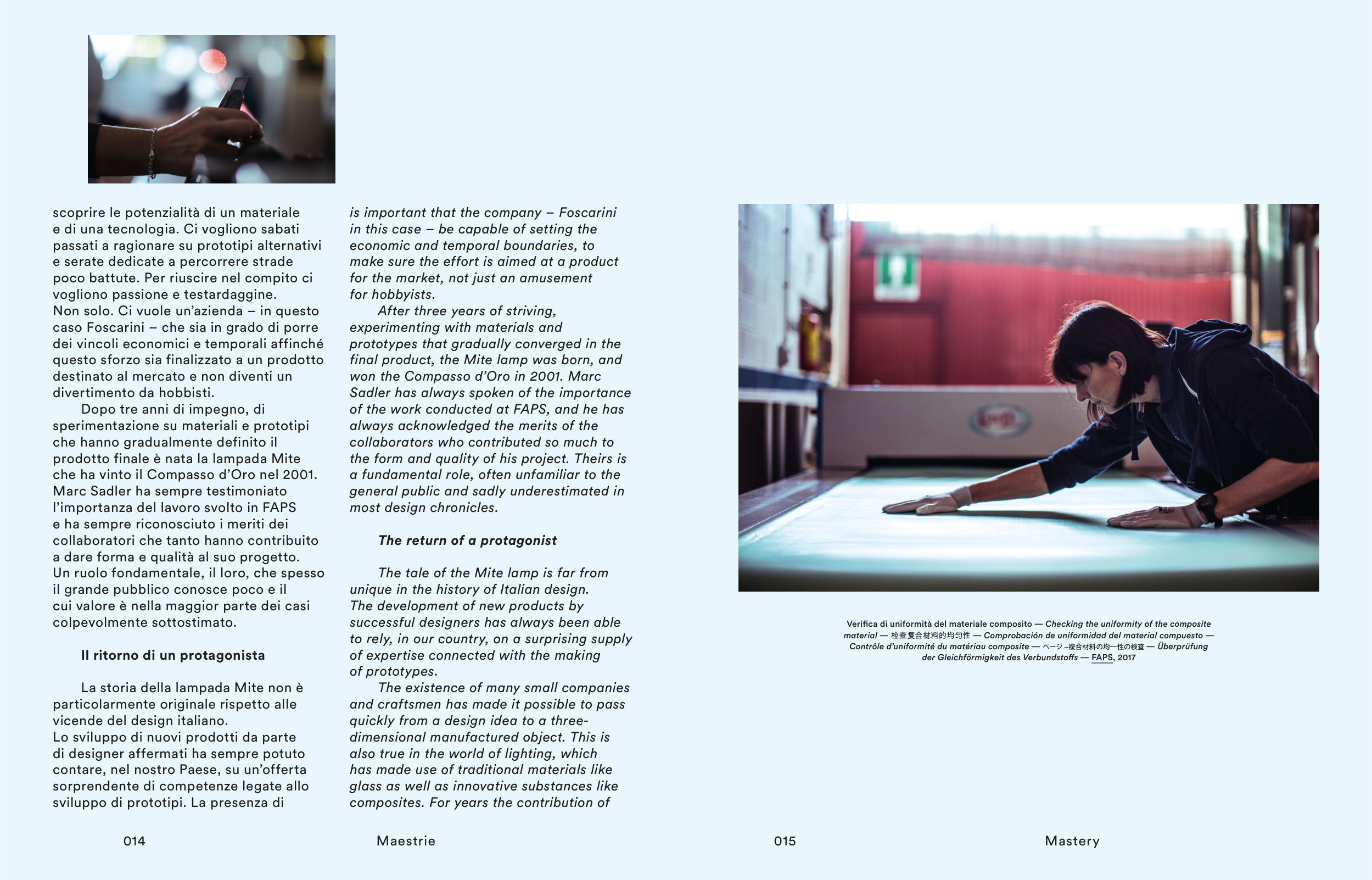015
Mastery
scoprire le potenzialità di un materiale
e di una tecnologia. Ci vogliono sabati
passati a ragionare su prototipi alternativi
e serate dedicate a percorrere strade
poco battute. Per riuscire nel compito ci
vogliono passione e testardaggine.
Non solo. Ci vuole un’azienda – in questo
caso Foscarini – che sia in grado di porre
dei vincoli economici e temporali affinché
questo sforzo sia finalizzato a un prodotto
destinato al mercato e non diventi un
divertimento da hobbisti.
Dopo tre anni di impegno, di
sperimentazione su materiali e prototipi
che hanno gradualmente definito il
prodotto finale è nata la lampada Mite
che ha vinto il Compasso d’Oro nel 2001.
Marc Sadler ha sempre testimoniato
l’importanza del lavoro svolto in FAPS
e ha sempre riconosciuto i meriti dei
collaboratori che tanto hanno contribuito
a dare forma e qualità al suo progetto.
Un ruolo fondamentale, il loro, che spesso
il grande pubblico conosce poco e il
cui valore è nella maggior parte dei casi
colpevolmente sottostimato.
Il ritorno di un protagonista
La storia della lampada Mite non è
particolarmente originale rispetto alle
vicende del design italiano.
Lo sviluppo di nuovi prodotti da parte
di designer affermati ha sempre potuto
contare, nel nostro Paese, su un’offerta
sorprendente di competenze legate allo
sviluppo di prototipi. La presenza di
is important that the company – Foscarini
in this case – be capable of setting the
economic and temporal boundaries, to
make sure the effort is aimed at a product
for the market, not just an amusement
for hobbyists.
After three years of striving,
experimenting with materials and
prototypes that gradually converged in the
final product, the Mite lamp was born, and
won the Compasso d’Oro in 2001. Marc
Sadler has always spoken of the importance
of the work conducted at FAPS, and he has
always acknowledged the merits of the
collaborators who contributed so much to
the form and quality of his project. Theirs is
a fundamental role, often unfamiliar to the
general public and sadly underestimated in
most design chronicles.
The return of a protagonist
The tale of the Mite lamp is far from
unique in the history of Italian design.
The development of new products by
successful designers has always been able
to rely, in our country, on a surprising supply
of expertise connected with the making
of prototypes.
The existence of many small companies
and craftsmen has made it possible to pass
quickly from a design idea to a three-
dimensional manufactured object. This is
also true in the world of lighting, which
has made use of traditional materials like
glass as well as innovative substances like
composites. For years the contribution of
014
Maestrie
Verifi ca di uniformità del materiale composito — Checking the uniformity of the composite
material — ���������� — Comprobación de uniformidad del material compuesto —
Contrôle d’uniformité du matériau composite — ページ ‒複合材料の均一性の検査 — Überprüfung
der Gleichförmigkeit des Verbundstoff s — FAPS, 2017


